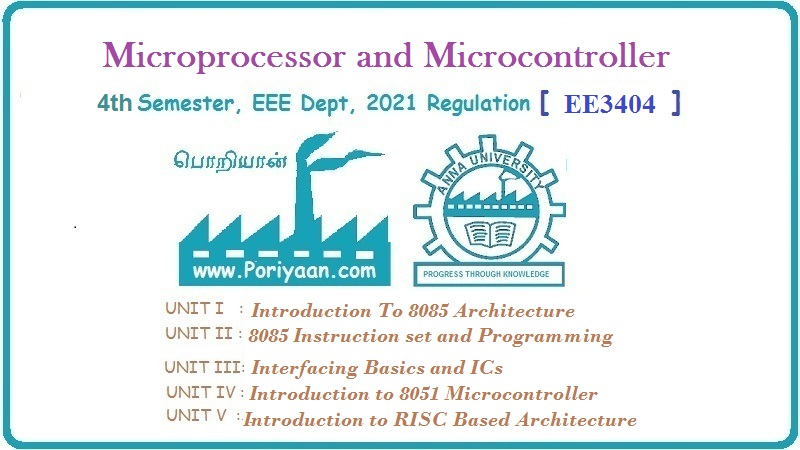Microprocessors and Microcontrollers: Unit I: (a) 8085 Processor
Features
8085 Processor
Question : 1. Explain architectural features of 8085.
Features
AU
: May-04
The
features of 8085 include :
1.
It is an 8-bit microprocessor i.e. it can accept, process, or provide 8-bit
data simultaneously.
2.
It operates on a single +5 V power supply connected at Vcc; power supply ground
is connected to Vss.
3.
It operates on clock cycle with 50 % duty cycle.
4.
It has on chip clock generator. This internal clock generator requires tuned
circuit like LC, RC or crystal. The internal clock generator divides oscillator
frequency by 2 and generates clock signal, which can be used for synchronizing
external devices.
5.
It can operate with a 3 MHz clock frequency. The 8085A-2 version can operate at
the maximum frequency of 5 MHz.
6.
It has 16 address lines, hence it can access (216) 64 kbytes of
memory. Q
7.
It provides 8-bit I/O addresses to access (28 ) 256 I/O ports.
8.
In 8085, the lower 8-bit address bus (A0 - A7) and data
bus (D0 - D7) are multiplexed to reduce number of
external pins. But due to this, external hardware (latch) is required to
separate address lines and data lines.
9.
It supports 74 instructions with the following addressing modes :
a)
Immediate b) Register c) Direct d) Indirect e) Implied.
10.
The Arithmetic Logic Unit (ALU) of 8085 performs :
a)
8-bit binary addition with or without carry.
b)
16-bit binary addition,
c)
2 digit BCD addition.
d)
8-bit binary subtraction with or without borrow.
e)
8-bit logical AND, OR, EX-OR, complement (NOT), and bit shift operations.
11.
It has 8-bit accumulator, flag register, instruction register, six 8-bit
general purpose registers (B, C, D, E, H and L) and two 16-bit registers (SP
and PC). Getting the operand from the general purpose registers is more faster
than from memory. Hence skilled programmers always prefer general purpose
registers to store program variables than memory.
12.
It provides five hardware interrupts : TRAP, RST 7.5, RST 6.5, RST 5.5 and
INTR.
13.
It has serial I/O control which allows serial communication.
14.
It provides control signals  to control the bus cycles and
hence external bus controller is not required.
to control the bus cycles and
hence external bus controller is not required.
15.
The external hardware (another microprocessor or equivalent master) can detect
which machine cycle microprocessor is executing using status signals  This feature is very useful when more than one processors are using common
system resources (memory and I/O devices).
This feature is very useful when more than one processors are using common
system resources (memory and I/O devices).
16.
It has a mechanism by which it is possible to increase its interrupt handling
capacity.
17.
The 8085 has an ability to share system bus with Direct Memory Access
controller. This feature allows to transfer large amount of data from I/O
device to memory or from memory to I/O device with high speeds.
18.
It can be used to implement three chip microcomputer with supporting I/O
devices like IC 8155 and IC 8355.
Review Question
1. Explain architectural features of 8085.
Microprocessors and Microcontrollers: Unit I: (a) 8085 Processor : Tag: : 8085 Processor - Features
Related Topics
Related Subjects
Microprocessor and Microcontroller
EE3404 MCU 4th Semester EEE Dept | 2021 Regulation | 4th Semester EEE Dept 2021 Regulation
